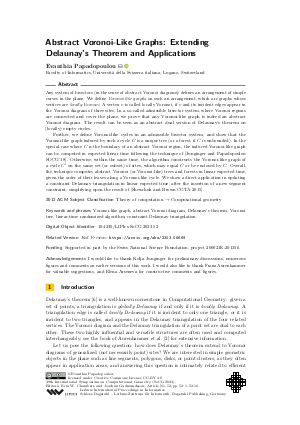Abstract Voronoi-Like Graphs: Extending Delaunay’s Theorem and Applications
Author
Evanthia Papadopoulou 
-
Part of:
Volume:
39th International Symposium on Computational Geometry (SoCG 2023)
Part of: Series: Leibniz International Proceedings in Informatics (LIPIcs)
Part of: Conference: Symposium on Computational Geometry (SoCG) - License:
 Creative Commons Attribution 4.0 International license
Creative Commons Attribution 4.0 International license
- Publication Date: 2023-06-09
File

PDF
LIPIcs.SoCG.2023.52.pdf
- Filesize: 1.08 MB
- 16 pages
Document Identifiers
Related Versions
- Full Version https://arxiv.org/abs/2303.06669
Subject Classification
ACM Subject Classification
- Theory of computation → Computational geometry
Keywords
- Voronoi-like graph
- abstract Voronoi diagram
- Delaunay’s theorem
- Voronoi tree
- linear-time randomized algorithm
- constraint Delaunay triangulation
Metrics
- Access Statistics
-
Total Accesses (updated on a weekly basis)
0PDF Downloads0Metadata Views
Abstract
Any system of bisectors (in the sense of abstract Voronoi diagrams) defines an arrangement of simple curves in the plane. We define Voronoi-like graphs on such an arrangement, which are graphs whose vertices are locally Voronoi. A vertex v is called locally Voronoi, if v and its incident edges appear in the Voronoi diagram of three sites. In a so-called admissible bisector system, where Voronoi regions are connected and cover the plane, we prove that any Voronoi-like graph is indeed an abstract Voronoi diagram. The result can be seen as an abstract dual version of Delaunay’s theorem on (locally) empty circles. Further, we define Voronoi-like cycles in an admissible bisector system, and show that the Voronoi-like graph induced by such a cycle C is a unique tree (or a forest, if C is unbounded). In the special case where C is the boundary of an abstract Voronoi region, the induced Voronoi-like graph can be computed in expected linear time following the technique of [Junginger and Papadopoulou SOCG'18]. Otherwise, within the same time, the algorithm constructs the Voronoi-like graph of a cycle C′ on the same set (or subset) of sites, which may equal C or be enclosed by C. Overall, the technique computes abstract Voronoi (or Voronoi-like) trees and forests in linear expected time, given the order of their leaves along a Voronoi-like cycle. We show a direct application in updating a constraint Delaunay triangulation in linear expected time, after the insertion of a new segment constraint, simplifying upon the result of [Shewchuk and Brown CGTA 2015].
Cite As Get BibTex
Evanthia Papadopoulou. Abstract Voronoi-Like Graphs: Extending Delaunay’s Theorem and Applications. In 39th International Symposium on Computational Geometry (SoCG 2023). Leibniz International Proceedings in Informatics (LIPIcs), Volume 258, pp. 52:1-52:16, Schloss Dagstuhl – Leibniz-Zentrum für Informatik (2023)
https://doi.org/10.4230/LIPIcs.SoCG.2023.52
BibTex
@InProceedings{papadopoulou:LIPIcs.SoCG.2023.52,
author = {Papadopoulou, Evanthia},
title = {{Abstract Voronoi-Like Graphs: Extending Delaunay’s Theorem and Applications}},
booktitle = {39th International Symposium on Computational Geometry (SoCG 2023)},
pages = {52:1--52:16},
series = {Leibniz International Proceedings in Informatics (LIPIcs)},
ISBN = {978-3-95977-273-0},
ISSN = {1868-8969},
year = {2023},
volume = {258},
editor = {Chambers, Erin W. and Gudmundsson, Joachim},
publisher = {Schloss Dagstuhl -- Leibniz-Zentrum f{\"u}r Informatik},
address = {Dagstuhl, Germany},
URL = {https://drops.dagstuhl.de/entities/document/10.4230/LIPIcs.SoCG.2023.52},
URN = {urn:nbn:de:0030-drops-179024},
doi = {10.4230/LIPIcs.SoCG.2023.52},
annote = {Keywords: Voronoi-like graph, abstract Voronoi diagram, Delaunay’s theorem, Voronoi tree, linear-time randomized algorithm, constraint Delaunay triangulation}
}
Author Details
Funding
Supported in part by the Swiss National Science Foundation, project 200021E-201356.
Acknowledgements
I would like to thank Kolja Junginger for preliminary discussions, numerous figures and comments on earlier versions of this work. I would also like to thank Franz Aurenhammer for valuable suggestions, and Elena Arseneva for constructive comments and figures.
References
- Alok Aggarwal, Leonidas J. Guibas, James B. Saxe, and Peter W. Shor. A linear-time algorithm for computing the Voronoi diagram of a convex polygon. Discrete and Computational Geometry, 4:591-604, 1989. URL: https://doi.org/10.1007/BF02187749.
- Franz Aurenhammer, Rolf Klein, and Der-Tsai Lee. Voronoi Diagrams and Delaunay Triangulations. World Scientific, 2013. URL: http://www.worldscientific.com/worldscibooks/10.1142/8685.
-
Cecilia Bohler, Rolf Klein, and Chih-Hung Liu. Abstract Voronoi diagrams from closed bisecting curves. International Journal of Computational Geometry and Applications, 27(3):221-240, 2017.

-
Cecilia Bohler, Rolf Klein, and Chih-Hung Liu. An efficient randomized algorithm for higher-order abstract Voronoi diagrams. Algorithmica, 81(6):2317-2345, 2019.

-
L. Paul Chew. Building Voronoi diagrams for convex polygons in linear expected time. Technical report, Dartmouth College, Hanover, USA, 1990.

-
B. Delaunay. Sur la sphère vide. A la memoire de Georges Voronoiï. Bulletin de l'Académie des Sciences de l'URSS. Classe des sciences mathématiques et naturelles, 6:793-800, 1934.

-
H. Edelsbrunner and R. Seidel. Voronoi diagrams and Arrangements. Discrete and Comptational Geometry, 1:25-44, 1986.

-
Kolja Junginger and Evanthia Papadopoulou. Deletion in Abstract Voronoi Diagrams in Expected Linear Time. In 34th International Symposium on Computational Geometry (SoCG), volume 99 of LIPIcs, pages 50:1-50:14, Dagstuhl, Germany, 2018.

-
Kolja Junginger and Evanthia Papadopoulou. On tree-like abstract Voronoi diagrams in expected linear time. In CGWeek Young Researchers Forum (CG:YRF), 2019.

-
Kolja Junginger and Evanthia Papadopoulou. Deletion in abstract Voronoi diagrams in expected linear time and related problems. arXiv:1803.05372v2 [cs.CG], 2020. To appear in Discrete and Computational Geometry.

-
Rolf Klein. Concrete and Abstract Voronoi Diagrams, volume 400 of Lecture Notes in Computer Science. Springer-Verlag, 1989.

-
Rolf Klein, Elmar Langetepe, and Z. Nilforoushan. Abstract Voronoi diagrams revisited. Computational Geometry: Theory and Applications, 42(9):885-902, 2009.

-
Rolf Klein, Kurt Mehlhorn, and Stefan Meiser. Randomized incremental construction of abstract Voronoi diagrams. Computational Geometry: Theory and Applications, 3:157-184, 1993.

- Evanthia Papadopoulou. Abstract Voronoi-like Graphs: Extending Delaunay’s Theorem and Applications. arXiv:2303.06669 [cs.CG], March 2023. URL: https://doi.org/10.48550/arXiv.2303.06669.
-
Micha Sharir and Pankaj K. Agarwal. Davenport-Schinzel sequences and their geometric applications. Cambridge university press, 1995.

-
Jonathan Richard Shewchuk and Brielin C. Brown. Fast segment insertion and incremental construction of constrained Delaunay triangulations. Computational Geometry: Theory and Applications, 48(8):554-574, 2015.

